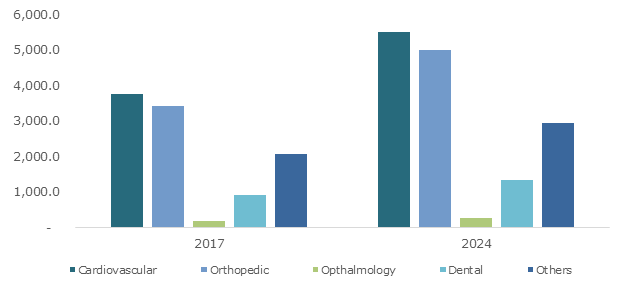Increasing geriatric population along with innovations in nanotechnology to drive the medical biomimetics market: North America to dominate the regional landscape
Publisher : Fractovia | Published Date : November 2016Request Sample
Medical Biomimetics is gaining high popularity as a future technology owing to enhanced support in the form of government funding for conducting advanced research pertaining to this this technology. For instance, the national cancer institute(NCI) and national institutes of health (NIH) are investing heavily in biomimetic tissue-engineering technologies to support the cancer research. Furthermore, growing old-age population, an increase in the rate of organ failure, and breakthroughs in nanotechnology are predicted to fuel the medical biomimetics market growth over the coming years. As per the UN, the global aging population which was nearly 809 million in 2012, is expected to reach approximately 2 billion by 2050. The UNOS (United Network for organ sharing) data figures display that there was a fifteen-fold rise in the number of patients requiring liver transplantation in the past 10 years and it is predicted to grow further in future with the rise in geriatric population as the rate of organ failure in elderly people is higher. This is expected to boost the application of medical biomimetics technologies for organ regeneration. According to Global Market Insights Inc. reports, “The medical biomimetics market worth USD 21.4 billion in 2015, is forecast to reach USD 34.4 billion by 2024, growing at a CAGR of 5.5% over the period of 2016-2024.”
Medical Biomemetics technology finds applications in plastic surgery, drug delivery, wound healing, and tissue engineering. It finds large applications in tissue engineering sector due to the recent technological breakthroughs in tissue & organ regeneration coupled with a rise in chronic ailments.
U.S. Medical Biomimetics Market size, by Product, 2012- 2024 (USD Mn)

Amongst the various kinds of medical biomimetics such as cardiovascular, dental, orthopedic, and ophthalmology, the cardiovascular medical biomimetics market dominated the global industry share by accounting for 36% of the overall share in 2015. It is expected to grow at a CAGR of 5.6% over the period of 2016-2024 owing to the growing occurrence of cardiovascular disorders in the rapidly increasing geriatric population. Furthermore, inactive lifestyle, growing obesity, and enhanced government support in the U.S. and Europe, is predicted to stimulate the cardiovascular medical biomimetics demand.
The North America medical biomimetics market share worth USD 10 billion in 2015, is predicted to witness a heavy surge over the period of 2016-2024 owing to the fast-technological changes, high level of patient awareness, increase in R & D activities, and a large presence of aging population with high ability to spend on healthcare services. The U.S. market is predicted to contribute significantly towards the regional growth over the coming timeframe.
The Asia Pacific medical biomimetics market is anticipated to record a CAGR of 7.7% over the period of 2016-2024 owing to the growth of medical tourism, a rise in aging base, and growing number of events like seminars, conferences, discussions, and forums on biomimetics held in Thailand, Malaysia, and Japan. Countries like China, India, and Japan are predicted to be major revenue pockets of the region.
The Latin America market is projected to witness a significant surge over the period of 2016-2024. Mexico and Brazil are expected to make substantial contributions towards the revenue growth of the region. The Europe medical biomimetics market is forecast to witness a high growth over the period of 2016-2024. UK and Germany are expected to boost the regional growth.
Key industry participants include Applied Biomimetics, Avinent, Biomimetics Technologies, BioHorizons, Forschungszentrum Jülich, and Hstar Technologies Corporation. The market players will invest in R&D activities and partner with research firms to create new products, as part of their growth strategies.